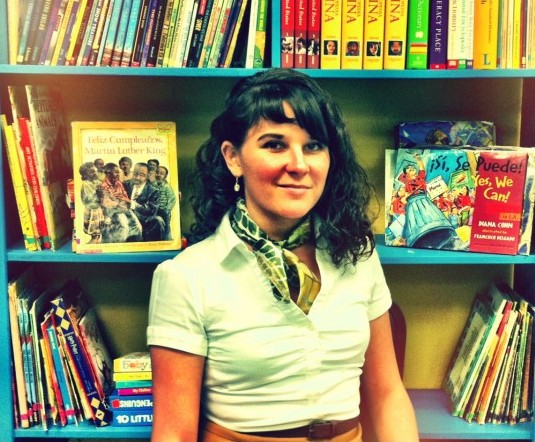 Kandace Vallejo.Construction workers may not be the most obvious constituency for a preacher of the locavore gospel. Yet in the airy stretches of Austin’s Pecan Springs neighborhood, Kandace Vallejo is making inroads from her perch in a bright blue building set on two acres. As membership programs coordinator at the Workers Defense Project (WDP), a workers center founded in 2002 to help construction workers — many of them undocumented immigrants — battle against rampant under- and non-payment of wages, Vallejo launched a food-themed education project for the children of WDP’s members in early 2010. Drawing on experience with the Student Farmworker Alliance and the Coalition of Immokalee Workers in south Florida — and with support from a hyper-competitive Institute for Agriculture and Trade Policy Food and Community Fellowship — Vallejo is building a compelling case for the idea that everyone cares about their meals. I caught up with Vallejo recently to hear how a pitch for local food plays with the children of day laborers.
Kandace Vallejo.Construction workers may not be the most obvious constituency for a preacher of the locavore gospel. Yet in the airy stretches of Austin’s Pecan Springs neighborhood, Kandace Vallejo is making inroads from her perch in a bright blue building set on two acres. As membership programs coordinator at the Workers Defense Project (WDP), a workers center founded in 2002 to help construction workers — many of them undocumented immigrants — battle against rampant under- and non-payment of wages, Vallejo launched a food-themed education project for the children of WDP’s members in early 2010. Drawing on experience with the Student Farmworker Alliance and the Coalition of Immokalee Workers in south Florida — and with support from a hyper-competitive Institute for Agriculture and Trade Policy Food and Community Fellowship — Vallejo is building a compelling case for the idea that everyone cares about their meals. I caught up with Vallejo recently to hear how a pitch for local food plays with the children of day laborers.
Q. What made you decide to bring food justice education to a group of construction workers?
A. Our membership asked us to. We bought a building in 2009 with a couple acres of land, and when our membership voted on what they wanted to see happen here, having a garden was one of the top priorities. In terms of doing youth programming around food issues, it just became apparent that it was something kids could really grasp because food is something that everybody interacts with. You can use it to talk about issues of access and economic inequality with a high schooler, and for a five-year-old we can talk about why it’s not fair that they don’t have a grocery stores in their neighborhood. That’s one way to talk about food. Another way is to get kids to appreciate their own cultural practice and use that appreciation to see and appreciate other cultural practices. It’s a good way to teach kids about difference.
Q. What are the biggest challenges around food faced by your group’s members?
A. The folks we’re working with definitely have issues with food access. Construction workers in Austin tend to work 10- to 14-hour days, and usually get paid a daily rate of anywhere from $60 to $90. Other folks are paid a weekly rate of $150 or $200, on the high end. So we know it’s drastically below minimum wage. And most of the folks we serve live in east Austin: a predominantly low-income, historically African-American and Latino or immigrant [neighborhood]. One of my first nights in the youth program, we were busting out some snacks for the kids — crackers and peanut butter — and I was asking if they had eaten dinner yet, and one of the kids said, “We don’t eat dinner.” And I was thinking, “Is that [because of] a religious practice”? And he said, “My dad has been out of work so we just don’t eat dinner, we don’t have money for that.”
East of I-35 [which bisects the city] there are just three grocery stores, and none of them are very well served; they’ve got produce that’s fallen off the back of the truck, and pretty small fresh food sections. Most of east Austin is considered a food desert by the USDA, and the closest food access points tend to be gas stations or Dairy Queens.
So, there’s access in terms of what they’re able to afford, but also access based on where they live.
It’s also a problem of time. If you’re working two jobs, it becomes even harder to find the time to go to another neighborhood to get healthy fresh food for your children and cook it. And the kids don’t have a lot of places where they’re learning about good food habits, or places where they can see those things being consumed by other people; the messages they are getting about food [are] coming from animals on television singing about neon-colored food products.
Q. You recently took your students on a field trip to Hyde Park, an upper-middle-class neighborhood known for its restaurants — and for having a Central Market, a high-end chain grocer. Why did you take the kids there, and what did they say after the trip?
A. We took students to two different neighborhoods. One group of kids went to Hyde Park, an upper-middle-class community, and the other went to the neighborhood around our community center, Pecan Springs. We chose them to illustrate the links between property size and appearance and what kinds of cars people drive, houses, things like that, and what kind of food options are available — so that we could highlight the connections between economic inequity and food.
One of the things the kids said was that the stores in [Hyde Park] had a lot more variety than the ones in their part of town, and both [groups] asked the same question at the end, which was Why? And they’ve begun to kind of explore this question … and they’ve also started to recognize that knowing this is the first step to making alternative options possible.
Q. There’s a lot of talk these days about how to make good, fresh food something everyone wants to eat. Some people argue that it’s a problem of changing food culture and preference; other people take a more structural approach. Where does your work fall on that continuum?
A. Talking about changing people’s cultural habits or preferences is a real slippery slope. We tend to imagine that we have a ton of answers; so many of us [in the food movement] have had access to great education and a lot of knowledge. Those things combined with the structural privileges that we’ve had access to put us in an interesting position when trying to recommend solutions for other people’s problems.
[Our members] are not saying they prefer to be obese and have diabetes and have heart disease in their family. What folks are saying here is they don’t have money. There’s no grocery stores. They would love to garden but they don’t have the land because they live in a trailer or a shared apartment … their kids are eating whatever is being given to them in free or reduced lunch in the school system. When we asked what they wanted, they wanted a community garden and cooking classes.
Q. What kind of food do members eat at WDP?
A. Last weekend, we had our Christmas party, and we had vegan posole alongside a traditional pork-based posole, and tamales and chips and salsa. We also had greens and quinoa. And when we have [that kind of food], people eat it. They are very interested in the different vegetables, and that curiosity leads them to want to try them — but they don’t know where to buy them or how to cook them. I just harvested a bunch of collards and chard and beets and some peas and the last few little tomatoes from our garden and gave them to a couple of members, and they said, “We’d eat them, but we don’t know how to cook them.” So I gave them a recipe for caldo gallego, a Cuban soup that features collard greens. One member said he’d bring the leftovers. I need to ask him about it.




